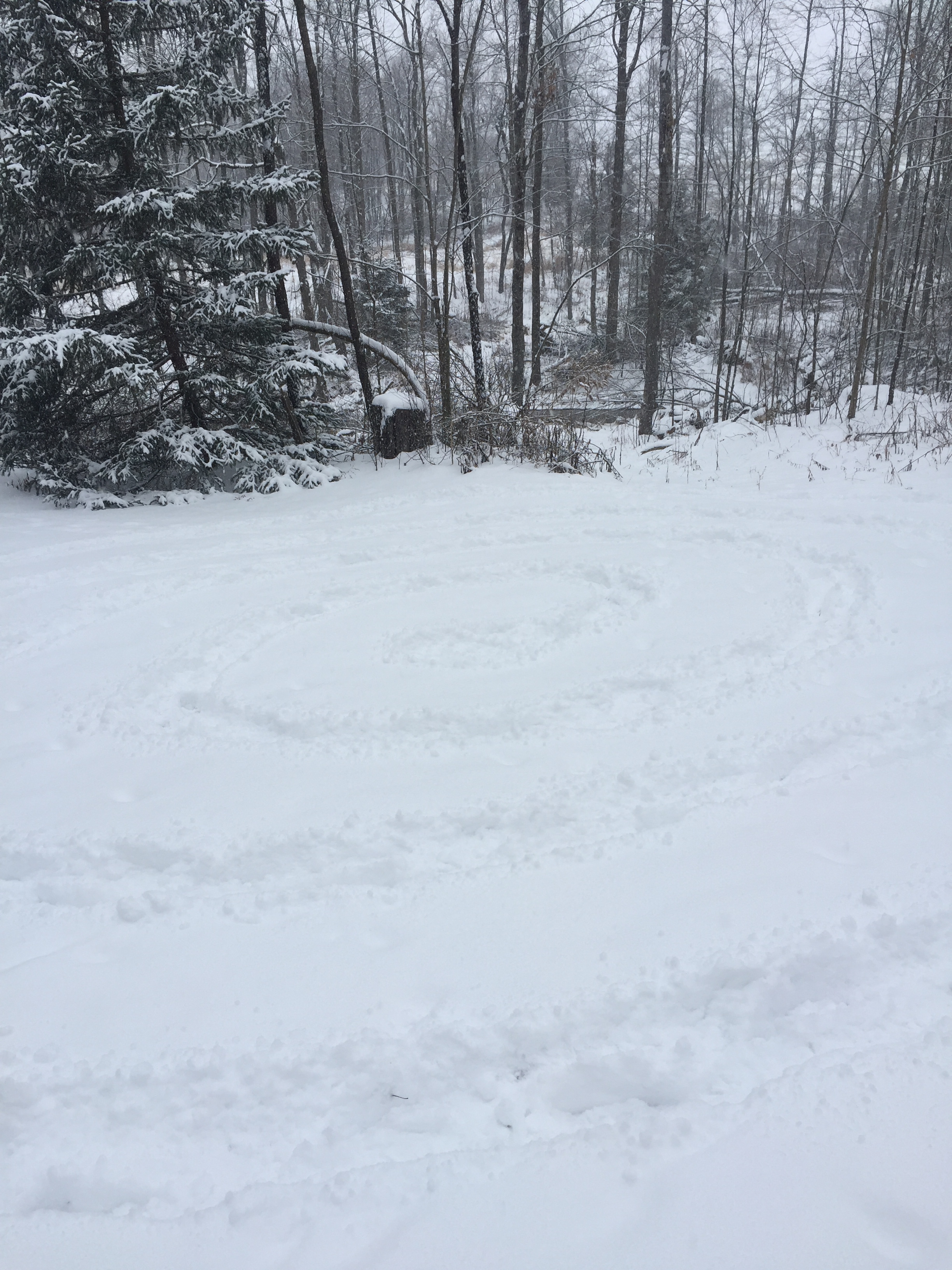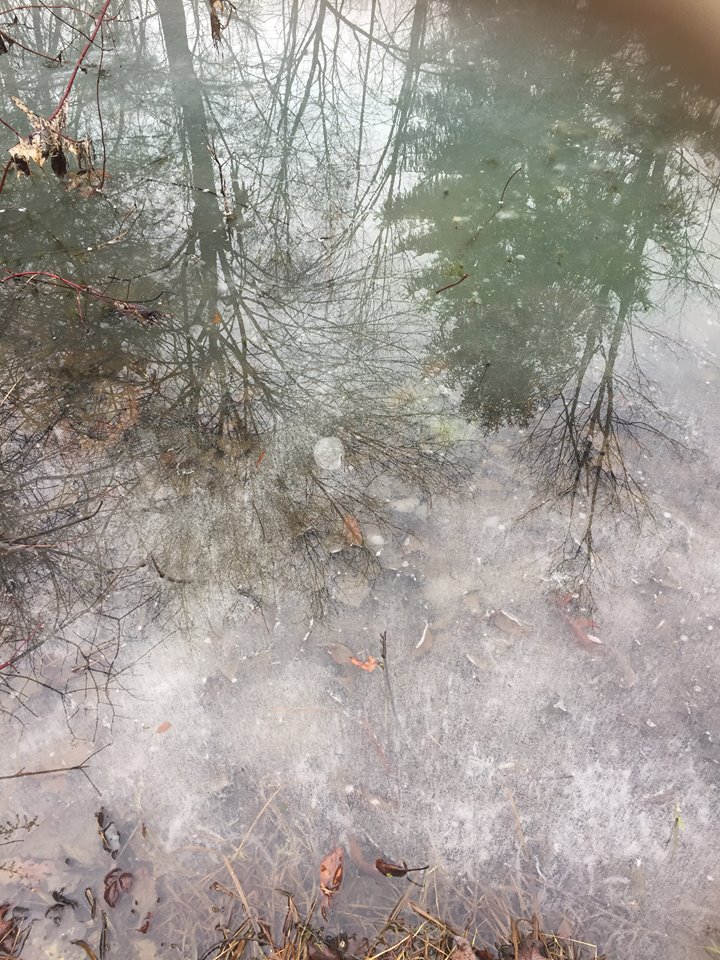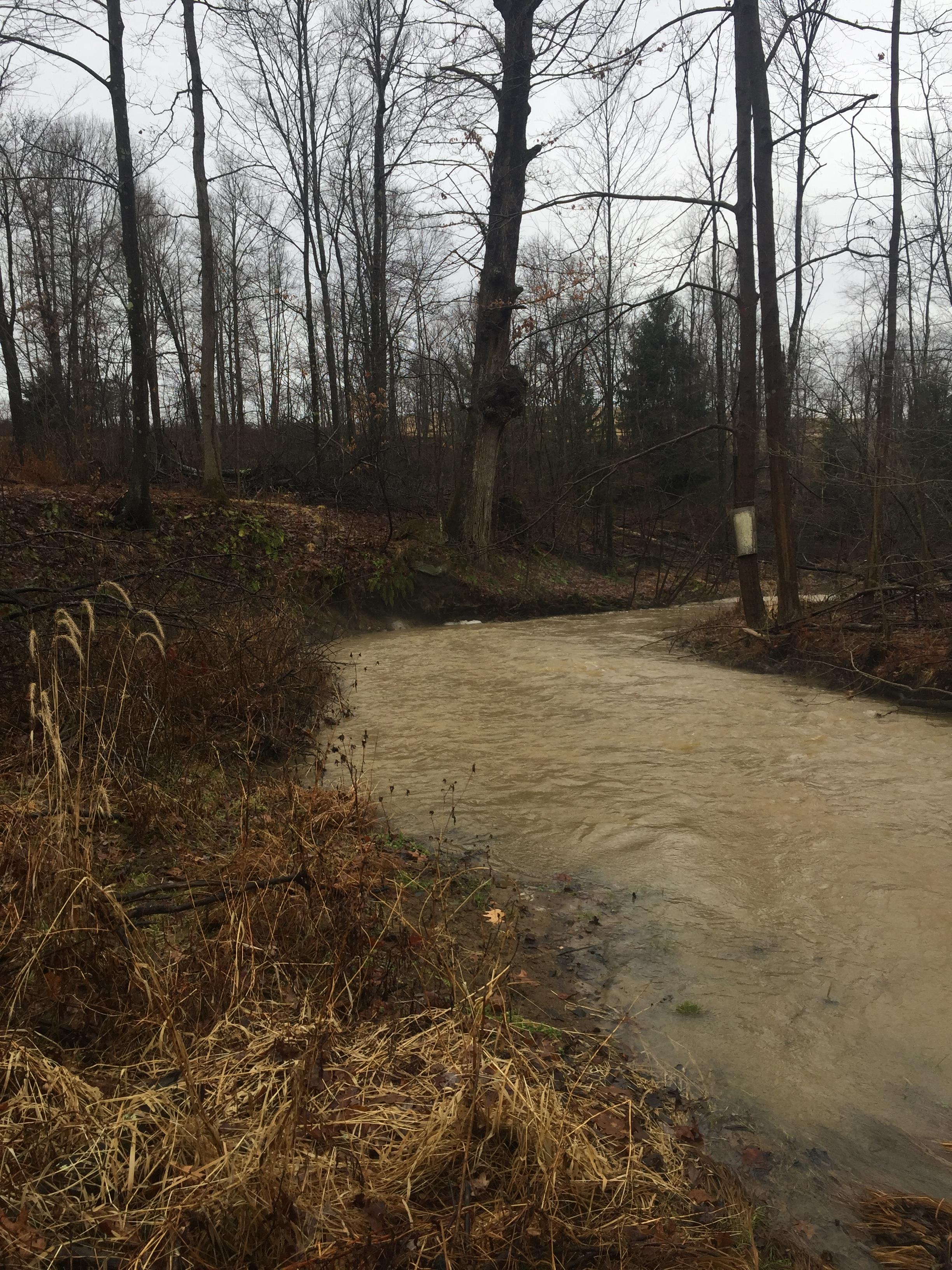It is late January. We had a very bout of cold weather these last few weeks, as I’m writing this, the weather broke and I’m out in the land for a longer stay since the sub-zero temperatures hit. When I came to my new home and new land in the fall, there was so much to do, just moving in and getting ready for winter, stacking wood, unpacking, painting, fixing things, building a greenhouse, and settling in that I didn’t have the time I wanted to spend with the land. But winter is good for such quiet communion, and so, I’ve been seeing what there is to discover.

As I’ve mentioned previously on this blog, in purchasing this land, I knew that part of my work here would be in documenting the regrowth of this land after the previous owners had about 3 acres of it selectively/sustainable timbered. Regrowth and regeneration is an incredible thing to bear witness to, and I am excited to experience and document it up close. And so, this year, I’m going to write one post a month in a series I’m calling “diary of a land healer.” The goal of this series is to document observations, interactions, and spiritual lessons from watching this beautiful ecosystem heal and regenerate–and the possibilities we have, as humans, to intervene in that process. Because land healing is a process, and because the inner work that facilitates healing is also in process, the thoughts that I present in these posts will also likely be in process.
As a person whose spiritual work centers on trees and land healing, I’m more often than not paying attention to what is wrong: the fallen trees, the timbering that was done, polluted streams, gas fracking wells, and so forth. As someone with a deeply spiritual relationship and love of trees, seeing any of them cut down is horrible. And yet, why this land chose me was because I was to bear witness, and help to regenerate, this forest ecosystem. And today, the land wants to offer me a lesson on nature’s regenerative processes.

And so, as I walk, my eyes naturally first gravitate to the stumps or some of the downed brush that the loggers left behind. But this land is not asking me to pay attention to the damage. It is asking me to pay attention to what is happening in terms of regrowth. That same giant oak stump, beautiful and powerful, grows mushrooms that weren’t there in the fall, but are here in January are bursting forth, even for a few fleeting warm days. Mushrooms are opportunists; at even the smallest amount of moisture, and temperature change, they take advantage. These mushrooms have done just that and are magnificently emerging–in the cold of winter–from this huge stump. That’s the magic of the microcosm: the work of the cycle of nutrients, of life and death, of decay and rebirth. Not only in nature does this happen, but also in our own bodies: many mushrooms, including turkey tail, growing here on this land, are used quite effectively for fighting cancer and free radicals in the human body.

I reach down to touch a mushroom and feel my hand go moist and slimy–even the slugs are out on this fine January day. We think the world is so cold, so frozen, so devoid of life after weeks of frigidly cold temperatures, but a single warm day proves this to be an illusion. Beneath the frozen pond, beneath the ice and snow, life awaits. It is a good lesson that nature teaches me every year–the land is always awake. Even two warm days encourage the emergence of insect life, the sprouting of mushrooms, and the movement of buzzing beetles in the pond. When the cold hits again, they simply slow down and wait it out.
This same lesson is a useful one in our own lives. I think sometimes we have periods of cold and dark where it seems like we are barely moving. Perhaps, we too, are waiting it out. But beneath that waiting, our roots are reaching deep, and the germination of the seed is already begun. Life is ready, at any moment, to spring forth. And in the most unexpected moments and ways, it does.

When all the snow melted away, the skeletons of the plants from last season are still there, their dried bodies moving against the breeze. I recognize the dried lobelia, goldenrod, and wild lettuce; three potent healing herbs. Lobelia serves as a powerful antispasmodic in small doses (dealing with cramps and spasms) and yet functions as an emetic (that is, makes you puke) in large doses. Goldenrod serenades the fall sun and waves goodbye as the sun sets upon the light half of the year. Goldenrod is a wonderful anti-inflammatory (internally and externally) and really useful for allergies as an anti-histamine. Wild lettuce has psychoactive properties and can be used for pain relief. As I look at the skeletons of these plants, I reach down to the dried lobelia. As I touch her, hundreds of tiny seeds spring forth, black specks upon the melting snow. Her children, soon, will arise in the spring.

As I walk, I check on the trees that I planted in the fall on Black Friday (what I call “buy nothing, do something” day). So many of the stakes of the tree tubes have gotten heaved up from the ice and cold, and I push them back into the earth. I look forward to seeing how many of the little seedlings take root and flourish here, their presence forever changing the make up of this land. Their planting is my first move to help this forest return to a pre-colonial form, an abundant food forest: chestnuts, pawpaws, hickories, and oaks that will one day produce a tremendous amount of abundance. It was the logging that cleared the way for me to replant. In permaculture design terms, the problem was the solution. In fact, everywhere I look, my permaculture design training kicks in. I have many things I want to do, so many ideas for this land. But when my head starts racing, I am told simply to “wait”. I know that whatever I don’t get to do in my time here, nature will do herself, in her own time and in her own way.
As I continue my walk, I come to a maple tree. The split in her trunk is quite large, yet she grows strong. An imperfection has made her perfect, in the sense that she is still alive and growing because she was not a good candidate for logging.

It is the same with the Guardian Oak in the Eastern part of the property overlooking the creek; a giant burl on the tree allowed this tree to survive. The burl, an imperfection, allowed this massive and ancient oak the ability to thrive. There are deep lessons here. If we are too perfect, if we strive to be too straight and tall and narrow, the loggers may come for us. Better to be weird, different, quirky, and certainly not commercially valuable–that is how we survive, and thrive, in these difficult times. It reminds me of the Wendell Berry poem “Mad Farmer Liberation Front,” where he writes “Your mind will be punched in a card / and shut away in a little drawer. / When they want you to buy something / they will call you. When they want you / to die for profit they will let you know. / So, friends, every day do something/ that won’t compute….Be like the fox / who makes more tracks than necessary, / some in the wrong direction.” Wiser words were never spoken, and perhaps, the oak and the maple have their own last laugh, for they are still growing strong, quirky as ever.

Another interpretation: the burl, which many would see as an imperfection, something wrong or diseased, is also the greatest strength for this oak. It asks us: how might we transform our sorrow/pain/suffering into a strength? How might our inperfections be our greatest gifts? The lesson of transformation whispers through the oak’s dried and still present leaves as they crackle in the January air.
I continue to look around, seeing the powerful life and strength here. This land, despite having been logged four times 40 years, is not a victim. The mushrooms growing in sub-zero temperatures laugh at the idea that they are anyone’s victim. The overflowing stream, Penn Run, that flows at the edge of my land babbles in joy at the ability to wash away the old and bring in the new. There is no pain here, only life. There is nothing here that should’t be just as it is. Being here is an honor and a gift.




Reblogged this on Paths I Walk.
Thank you for the reblog!
Sometimes one must see destruction in order to experience creation. Senses grow numb. Thank you for sharing your post. More people need to understand.
Yes, this is a beautiful way to put it. Thank you for reading
Hi. This was a beautiful piece of writing. I’ll save if for later to read again. I have just arrived at the Unitarian Universalist Church in Greenville, SC where they are holding an I m b l o c service this morning. I’ve been reading lots of OBOD material recently and I really relate to it. Congratulations on being keynote speaker for MAGUS. Happy I m b l o c. Jane
Hi MaryJane, Thanks for reading and enjoy your service!
It’s incredible how much you can learn from looking at Nature and her works – about resilience, optimism and the celebration of difference and diversity. A lovely piece of inspiration: it touched my heart and got me thinking.
Beautifully expressed. I’ve so enjoyed your blog and your Awen Alone. So grateful that you share your work and wisdom with others.
Thank you, Denise! Thank you so much for reading!
Hi Dana,
It is good to have you back. I will meditate on some of these ideas especially about our imperfections and illnesses being gifts.
Hugs from Max
Reblogged this on Rattiesforeverworldpresscom.
Congrats :p
Healing from a minor surgery and as this is mid Michigan in January, I am unable to enjoy the walks that have kept me sane and alive, but your post/note/whatever was exactly what I needed. Thank you and be well.
Congratulations on partnering with this new land! I was just thinking of you last night, wondering what came of your search and how you were settling into whatever new found you. So lovely to find this update this morning. Blessings, joy and peace in this new phase.
Laura, thank you! I hope you are doing well. Things are settling in here nicely….its nice to be “home” again :).
You’re welcome, Dana. Yes, things are going so well here! We just love it here, and David found a much better job than he was ever able to get in Goshen’s unusual economy. Life is snowy, gorgeous and good. Enjoy settling in and getting to know the Land.
Enjoy settling in and getting to know the Land.
I love it when spirit guides the way!
Reblogged this on tinderness and commented:
Eine sehr achtsame Artikelserie gefunden, die es lohnt, zu lesen und “nachzugehen”.
Thank you for the reblog!
Hi Dana, I discovered your blog last fall in a search for how to make smudge sticks. You write very well. And I love the quote from Wendell Berry. I’ve always felt kinship with the fox.
Take a look at the whole poem–it is one of my very favorite poems ever :).
Hello, you might remember I had shared a tidbit about flower essences (energetic medicine derived from flowers, but not the same as essential oils). The one I mentioned was jewelweed having the ability to calm irritated nerves/emotions, in tandem with the actual plant parts having the ability of soothing poison ivy rashes. In further research, I ran across a mention of Gooseberry, which may interest you. “Gooseberry (Ribes oxyacanthoides)… Gooseberry helps to restore vitality and heal the void left when something has been taken that belonged in place… Gooseberry also helps land recover from logging or other traumas…. The Angels here at the farm had us plant and use Gooseberry very early in the farm’s history. In retrospect, I realize Gooseberry was used as a balancing tool to heal the wounds held by the land when we arrived.” This reminds me of your description of certain plants appearing in disturbed/traumatized land to begin healing, and I can’t help but think this tidbit of info is relevant to your work with the land. If you’d like the link, let me know. Sometimes bloggers don’t like outside links posted in comments, so I try to ask first.
Hi Kieron, I do remember your comments about flower essences. Thank you so much for sharing this information about gooseberry….this is really, really helpful. I wonder if this kind of gooseberry flower essence could be used, and if gooseberries could be a good regenerative plant. They are native here, but a bit hard to find. Yes, please share the link–I would love to read it.
The site’s entry for Gooseberry is pretty much what you see above but here is a link to Dandelion which I think you’ll agree is pretty transformative itself. https://www.greenhopeessences.com/essences/dandelion From there you can research to your heart’s content. The Additional Essences List section on https://www.greenhopeessences.com/find-essences will bring you to a PDF where you can find many additional listings that aren’t featured in the main site. They are located in NH, so the farm is relatively near you.
https://www.greenhopeessences.com/essences/dandelion From there you can research to your heart’s content. The Additional Essences List section on https://www.greenhopeessences.com/find-essences will bring you to a PDF where you can find many additional listings that aren’t featured in the main site. They are located in NH, so the farm is relatively near you. 